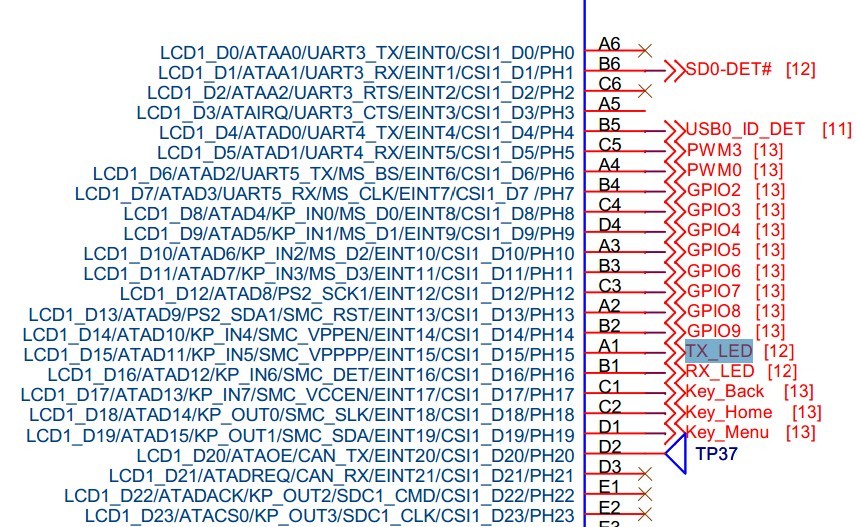最近调驱动时,调试led时遇到了点问题,于是回过头来再写个led裸板程序。在我写的pcDuino第一个裸板程序uart的基础上,再写个led裸板程序还是很轻松的。很多人觉得没有必要写什么pcDuino裸板程序,觉得没啥意义。我觉得可以用来熟悉硬件,特别是想做底层驱动开发,以及系统移植,熟悉底层硬件还是有用的。其实做底层驱动开发,也是跟硬件打交道,硬件相关的操作和裸板程序是一样的。下面介绍怎样在pcDuino上跑一个最简单的led裸板程序。
开发环境:
系统:ubuntu 10.04.4
单板:pcDuino
编译器:arm-2009q3-67-arm-none-linux-gnueabi-i686-pc-linux-gnu.tar.bz2
目标:实现pcDuino上的TX_LED闪烁
一、硬件介绍
仔细看pcDuino上的原理图和pcDuino的手册,发现二者不是完全对应的,还是以原理图为准。根据原理图知道TX_LED是接到PH15上,可以当做普通IO口用,不需要连跳线
二、编写源代码
主要是看手册30.Port Controller,根据手册写led初始化程序主要包括设为输出、是能上拉及Multi-Driving寄存器设置。包括start.S、main.c、clock.c、clock.h、Makefile,下面贴出全部代码
文件start.S:
.global _start
_start:
ldr sp, =0x00007f00
b main
#include "clock.h"
#define PH_CFG1 (*(volatile unsigned int *)0x01c20900)
#define PH_DAT (*(volatile unsigned int *)0x01c2090C)
#define PH_DRI (*(volatile unsigned int *)0x01c20910)
#define PH_PULL (*(volatile unsigned int *)0x01c20918)
void gpio_init()
{
/*PCDUINO GPIO4--PH9:
*bit[6:4]:PH9_SELECT 001:OUTPUT
*PCDUINO GPIO5--PH10:
*bit[10:8]:PH10_SELECT 001:OUTPUT
*/
PH_CFG1 |= ((0x1<<4)|(0x1<<8)|(0X1<<28));
PH_DRI = 0XFFFFFFFF;
PH_PULL = 0X55555555;
}
void delay()
{
volatile int i = 0x300000;
while (i--);
}
int main(void)
{
char c;
clock_init(); /* 初始化时钟 */
gpio_init();
while (1)
{
PH_DAT = 0x00;
delay();
PH_DAT = 0xffff;
delay();
}
return 0;
}
#define CPU_AHB_APB0_CFG (*(volatile unsigned int *)0x01c20054)
#define PLL1_CFG (*(volatile unsigned int *)0x01c20000)
#define APB1_CLK_DIV_CFG (*(volatile unsigned int *)0x01c20058)
#define APB1_GATE (*(volatile unsigned int *)0x01c2006C)
void sdelay(unsigned long loops)
{
__asm__ volatile("1:\n" "subs %0, %1, #1\n"
"bne 1b":"=r" (loops):"0"(loops));
}
void clock_init(void)
{
/*AXI_DIV_1[1:0] AXI_CLK_DIV_RATIO 00:/1 AXI Clock source is CPU clock
*AHB_DIV_2[5:4] AHP_CLK_DIV_RATIO 01:/2 AHB Clock source is AXI CLOCK
*APB0_DIV_1[9:8] APB0_CLK_RATIO 00:/2 APB0 clock source is AHB2 clock
*CPU_CLK_SRC_OSC24M[17:16] CPU_CLK_SRC_SEL 01:OSC24M
*/
CPU_AHB_APB0_CFG = ((0<<0)|(0x1<<4)|(0<<8)|(1<<16));
/*bit31:PLL1_Enable 1:Enable
*bit25:EXG_MODE 0x0:Exchange mode
*bit[17:16]:PLL1_OUT_EXT_DIVP 0x0:P=1
*bit[12:8]:PLL1_FACTOR_N 0x10:Factor=16,N=16
*bit[5:4]:PLL1_FACTOR_K 0x0:K=1
*bit3:SIG_DELT_PAT_IN 0x0
*bit2:SIG_DELT_PAT_EN 0x0
*bit[1:0]PLL1_FACTOR_M 0x0:M=1
*The PLL1 output=(24M*N*K)/(M*P)=(24M*16*1)/(1*1)=384M is for the coreclk
*/
PLL1_CFG = 0xa1005000;
sdelay(200);
CPU_AHB_APB0_CFG = ((0<<0)|(0x1<<4)|(0<<8)|(2<<16));//CPU_CLK_SRC_SEL 10:PLL1
/*uart clock source is apb1,config apb1 clock*/
/*bit[25:24]:APB1_CLK_SRC_SEL 00:OSC24M
*bit[17:16]:CLK_RAT_N 0X0:1 The select clock source is pre-divided by 2^1
*bit[4:0]:CLK_RAT_M 0x0:1 The pre-devided clock is divided by(m+1)
*/
APB1_CLK_DIV_CFG = ((0<<5)|(0<<16)|(0<<24));
/*open the clock for uart0*/
/*bit16:UART0_APB_GATING 1:pass 0:mask*/
APB1_GATE = (0x1<<16);
}
void clock_init(void);led.bin:start.S main.c clock.c
arm-none-linux-gnueabi-gcc -nostdlib -c start.S -o start.o
arm-none-linux-gnueabi-gcc -nostdlib -c main.c -o main.o
arm-none-linux-gnueabi-gcc -nostdlib -c clock.c -o clock.o
arm-none-linux-gnueabi-ld -Ttext 0xD0020010 start.o main.o clock.o -o led_elf
arm-none-linux-gnueabi-objcopy -O binary -S led_elf led.bin
clean:
rm -rf *.o *.bin led_elf *.dis
三、编译、测试
1.安装交叉编译链,给个链接 http://code.google.com/p/smp-on-qemu/downloads/list 选择arm-2009q3-67-arm-none-linux-gnueabi-i686-pc-linux-gnu.tar.bz2并下载。然后在ubuntu下直接解压即可,过程就不说了,还不清楚的看Ubuntu 10.04.4开发环境配置。
2.编译
change@change:~$ cd Si/A10/2_led/
change@change:~/Si/A10/2_led$ ls
clock.c clock.h main.c Makefile mksunxiboot start.S
change@change:~/Si/A10/2_led$ make
arm-none-linux-gnueabi-gcc -nostdlib -c start.S -o start.o
arm-none-linux-gnueabi-gcc -nostdlib -c main.c -o main.o
arm-none-linux-gnueabi-gcc -nostdlib -c clock.c -o clock.o
arm-none-linux-gnueabi-ld -Ttext 0xD0020010 start.o main.o clock.o -o led_elf
arm-none-linux-gnueabi-objcopy -O binary -S led_elf led.bin
change@change:~/Si/A10/2_led$ ./mksunxiboot led.bin leds.bin
File size: 0x154
Load size: 0x154
Read 0x154 bytes
Write 0x200 bytes
change@change:~/Si/A10/2_led$
其中有个./mksunxiboot led.bin leds.bin要注意,不经过mksunxiboot工具 的.bin文件,pcDuino是运行不了的。这个工具在官网上都有下。现在的处理启动都很复杂,内有固化有bl0代码,在跳转到bl1时需要校验程序的合法性,这个工具mksunxiboot简单点少就是给我们程序加了点头部,让处理器能够识别我们写的代码。你可以分析led.bin和leds.bin的反汇编代码,就一目了然了。这部分感兴趣的可以一起讨论。
3.测试
上面生成的leds.bin就可以放到板子上运行了。为了不破会NAND中的系统,直接放到tf卡运行。不用担心那个先启动,看全志手册就知道pcDuino默认先从tf卡启动,只有tf卡没有启动的引导程序才会跳到NAND启动。插上tf卡到PC机
change@change:~/Si/A10/2_led$ sudo dd if=/dev/zero of=/dev/sdb bs=1M count=1
1+0 records in
1+0 records out
1048576 bytes (1.0 MB) copied, 0.425886 s, 2.5 MB/s
change@change:~/Si/A10/2_led$ sudo dd if=leds.bin of=/dev/sdb bs=1024 seek=8
0+1 records in
0+1 records out
512 bytes (512 B) copied, 0.00600667 s, 85.2 kB/s
change@change:~/Si/A10/2_led$
然后取下tf卡,插到pcDino上,RX LED就开始闪烁了。如果你手上有led,接到GPIO4、GPIO5也会闪烁。对底层硬件感兴趣的,一起讨论,有问题的请直接留言。























 704
704

 被折叠的 条评论
为什么被折叠?
被折叠的 条评论
为什么被折叠?








